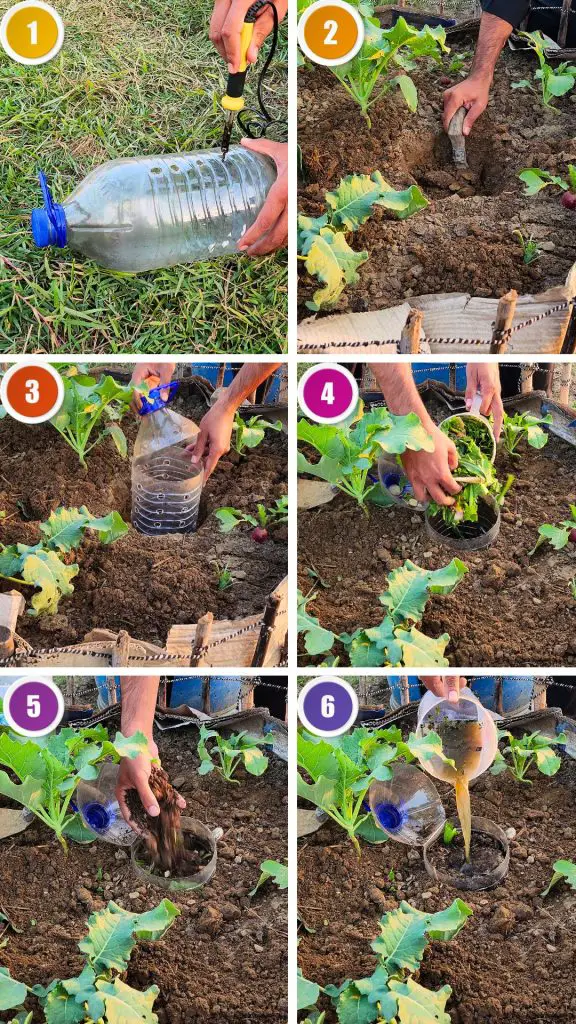Creating a garden that feeds itself is not just possible—it’s surprisingly easy and affordable. By combining a raised bed with an in-bed composting system, you can turn your garden into a self-sustaining ecosystem.
The idea is simple: instead of throwing away your kitchen scraps, you feed them directly into the soil through a small composting unit built right inside the bed. This natural system continuously produces organic matter and nutrient-rich compost tea, which goes straight to your plants’ roots. Let’s go step by step and understand how to build and use this powerful system.
Watch complete video here:
Preparing the Garden Bed
Before setting up the composting system, the bed itself needs to be ready. A raised bed is the best choice because it gives you full control over the soil, drainage, and layers. You can build it with simple materials like bamboo sticks, wooden planks, or even old barrels. The shape doesn’t matter much, but circular or rectangular beds tend to work best. Once the boundary is made, fill it with layers that support long-term fertility.
Start with a layer of loamy soil at the bottom, followed by a thick layer of dried grass, straw, or leaves. These materials create air spaces and help with water retention. Add another layer of garden soil on top, then finish with a generous layer of fully decomposed manure or compost. Water it deeply to let everything settle. After a couple of weeks, the layers will start blending naturally. Microbes and earthworms will begin moving through the soil, making it alive and ready for the composting system.

The Idea Behind In-Bed Composting
Traditional composting systems are usually built in a separate bin or pit, and once the compost is ready, it’s carried to the garden. But the in-bed composting system does this work right inside the bed. It saves time, space, and energy, while also ensuring that the nutrients stay where they belong—around your plants’ roots.
In this method, a container is placed inside the bed, where kitchen waste slowly decomposes. The container has holes that allow air and moisture to move freely. As the waste breaks down, it releases compost tea, which seeps through these holes into the surrounding soil. This liquid is full of nutrients and beneficial microbes, giving your plants continuous feeding. The process also keeps your soil structure healthy, improves drainage, and attracts earthworms. It’s a natural and sustainable solution for long-term soil fertility.
Choosing and Preparing the Composting Container
You don’t need fancy tools or expensive materials to build this system. The main item you’ll need is a used 5-litre water bottle. This common plastic container works perfectly as a mini composting bin. Its size is ideal—it’s large enough to hold waste but small enough to fit neatly in a garden bed.
First, clean the bottle properly and remove any labels. With a soldering iron or heated metal rod, make small holes all around the sides and bottom of the bottle. These holes are crucial because they allow oxygen to enter and compost tea to flow out. Without proper air circulation, the waste would rot instead of composting. Make sure the holes are evenly spaced and not too large—just enough for airflow and drainage.
Next, make a partial cut at the top of the bottle so it can open and close easily. This flap will act as a lid, keeping flies out while still letting air in. It also makes it convenient to add new waste or pour in compost activators when needed. Once this is done, the bottle is ready to be installed.
Installing the Composting System Inside the Bed
Choose a spot near the center of your garden bed for placing the bottle. This location allows the compost tea to spread evenly through the soil. With a small spade, dig a hole deep enough to fit the bottle securely. The top opening should remain above the soil so you can access it easily.
Once the hole is ready, insert the bottle and press soil around the sides to fix it firmly in place. It should stand upright and feel stable. The holes you made earlier will now be surrounded by soil, allowing the compost tea to seep directly into the root zone. This design makes sure that every drop of nutrient-rich liquid benefits your plants instead of being wasted.
Adding Organic Waste and Compost
After the bottle is fixed in the bed, it’s time to feed it. Start by adding kitchen waste such as fruit and vegetable peels, old leaves, and tea waste. Avoid adding cooked food, oily items, or meat. Natural, plant-based waste breaks down much faster and produces healthy compost.
Once you’ve added some waste, sprinkle a handful of ready compost or old garden soil on top. This step introduces beneficial microbes that will begin breaking down the fresh waste. These microbes are the real workers—they convert the organic matter into compost and release nutrients into the soil. The compost also helps balance moisture and prevents bad smells.
As the waste starts decomposing, it will shrink in size. You can keep adding more waste every few days. The system works continuously; as long as you feed it, it will keep producing compost. Over time, the waste turns into rich, dark organic matter that feeds your soil naturally.
Activating the Compost with Liquid Fertilizer
To make this system even more powerful, you can add a natural liquid fertilizer to it. One of the best mixtures can be made from charcoal, compost, molasses, and water. This blend is rich in beneficial microbes and acts as a microbial booster for your composting system.
Charcoal in the mix helps retain moisture and nutrients. Compost brings in billions of living microorganisms. Molasses serves as food for these microbes, helping them multiply quickly. When you pour this liquid into your composting bottle, it activates the decomposition process almost instantly. The microbes start breaking down the kitchen waste faster, creating heat and releasing nutrient-rich liquid that seeps into the soil.
This compost tea spreads through the bed, feeding plants naturally. It contains nitrogen, phosphorus, potassium, and trace minerals—all essential for plant growth. The continuous flow of this tea keeps the roots healthy and encourages strong growth without the need for chemical fertilizers.
Maintaining the Composting System
Once your in-bed composting system is up and running, maintenance is simple. Keep adding organic waste regularly, a small amount at a time. If you notice the material inside becoming too dry, add a little water to maintain moisture. If it becomes too wet, mix in some dry leaves or soil. Balance is key to good composting.
Every few weeks, stir the contents lightly using a stick. This helps mix old and new material and improves air circulation. You can also pour a little more of the charcoal-molasses fertilizer every 10–15 days to keep microbial activity high. Within a few weeks, you’ll notice that the waste at the bottom turns into dark, crumbly compost.
You don’t even need to remove it often. The compost tea that seeps through the holes ensures that nutrients are constantly reaching your plants. Once every few months, you can take out the remaining solid compost and mix it into the soil around the plants. This keeps your bed fertile all year long.
Benefits of the In-Bed Composting System
The biggest advantage of this system is sustainability. You are recycling kitchen waste directly into your garden, reducing garbage, and creating natural fertilizer for free. The soil stays soft and full of life because the composting process encourages earthworms and beneficial microbes to thrive. These living organisms improve soil structure and make nutrients easily available to plants.
The compost tea produced by the system keeps your plants strong and disease-resistant. The constant slow feeding ensures steady growth instead of sudden nutrient spikes. Since it’s an ongoing process, the plants never run out of food, and the soil remains healthy and active.
This system also saves water. The organic matter inside the bed retains moisture, meaning you need to water less often. The circular nature of the system—where waste turns into compost, compost turns into soil food, and soil supports plant growth—makes it a complete eco-cycle that works without interruption.
